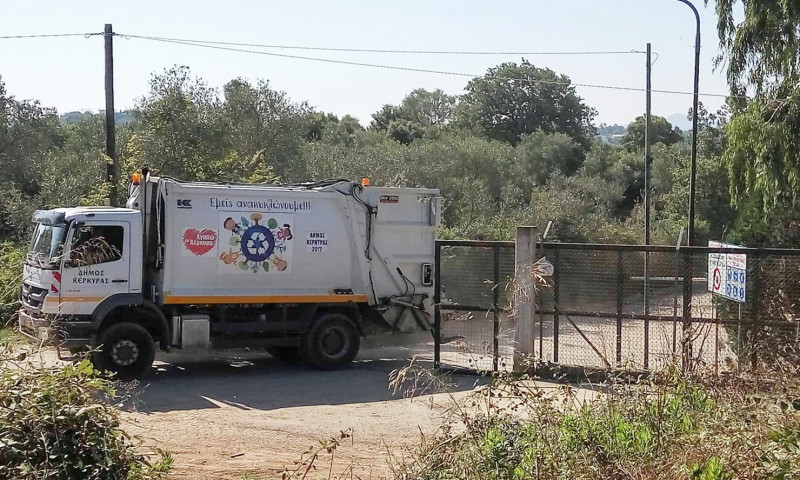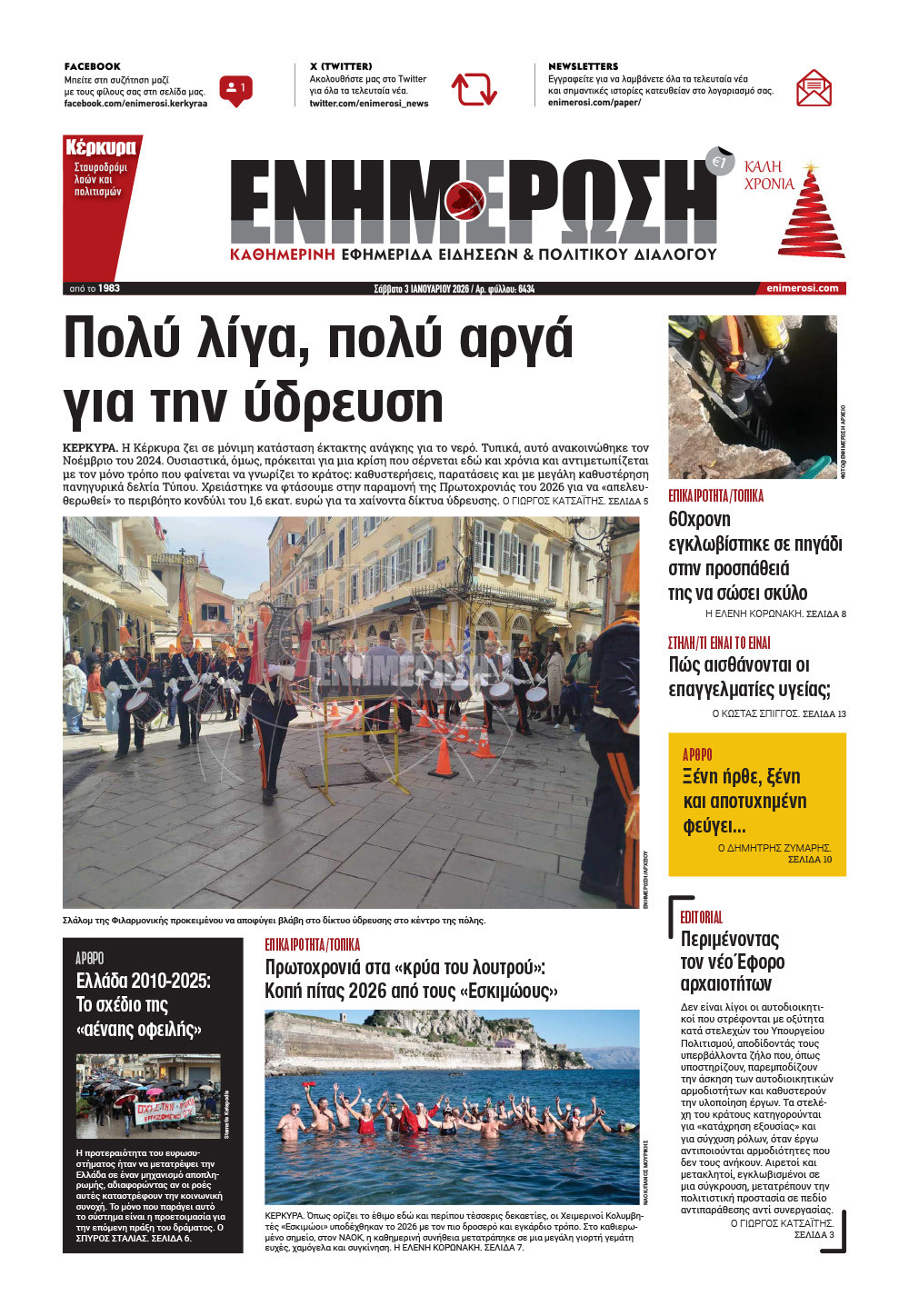Where does the recyclable waste go?

waste management
05 Ιουλίου 2018
/ 08:24
CORFU. The Enimerosi camera followed the trucks with recyclable waste. What did it find out?
We decided to investigate following widespread concern about what happens to the recyclable waste once it has been collected from the blue bins. Is it maybe just being deposited with the mixed waste? Are our efforts to separate it from the other waste and clean it going to waste? Are they just kidding us?
The lack of trust is justified as over the last few years most people have seen with their own eyes that both green and blue bins are emptied into the same refuse trucks and simply end up at Temploni landfill. The refuse crisis, however, opened a lot of wounds but at least created a much greater interest in recycling. People are asking questions, cultural societies are taking the initiative of setting up local 'green spots'. The circumstances have 'ripened' so much (or perhaps 'rotted') that separation at source has become imperative.
Enimerosi visited the facility where the recyclable waste is collected - the Recyclable Waste Sorting Centre (KDAY), which until recently has been operating below its potential. Our camera filmed the trucks with recyclable waste entering through the main entrance of the Temploni landfill and, after having been weighed, head for the KDAY located next to the landfill and depositing the waste. This is when the sorting begins but, local residents say, there isn't enough personnel for the 'mountain' of waste. The Deputy Mayor for Cleansing Services Spyros Aspiotis told Enimerosi that there are 12 workers employed there but admitted that it wasn't enough. The facility belongs to the Hellenic Recovery Recycling Corporation and the work is sub-contracted to a company (Lavranos Bros, who have just been given the contract again) which manages the collection and sorting processes.
What happens with the recyclable materials
In the first sorting the non-recyclable waste is removed and taken back to the baler. The reverse happens with recyclable packaging that has been dumped in green bins. SYDISA Vice-President Nikos Korakianitis stresses the problem with uncontrolled dumping in the refuse bins. "The problem lies with the refuse collection. The rubbish is just thrown in the bins without any kind of separation. The collection is operating properly but there may be just 30-40% of the total which is actually recyclable and the rest is mixed waste. This means that we keep just the recyclable materials and send the rest back to the baler. If the network of refuse bins was functioning properly we wouldn't have to take waste back and forth. This is why we are trying to set up green spots in one network, beginning with what already exists - for example, Liapades, Sinies, Spartylas etc. These green spots have only blue bins and it dumping rubbish there is prohibited, so we have 100% recyclable materials."
The Collection Point at the Emporiko Kentro
What is clear is that work is still needed on raising 'recycling' awareness.
It shouldn't be taken for granted that the public knows about recycling. It would simple and without cost for the Cleansing Services to issue guidelines for the proper way to sort waste with printed materials and electronically. A map could also be made available with the island's green spots.
"The collection point in the parking area at the Emporiko Kentro worked well for a week following the refuse crisis," said Mr. Korakoanitis. "Now that the roads have been cleaned up substantially interest has fallen. There needs to be a continuous interest from the public."
On the other hand, Deputy Mayor for Cleansing Spyros Aspiotis considers that there has been an improvement in the amount of clean materials as well as in the collaboration between the recycling centre and the landfill where the mixed waste is baled. We have requested data from the Cleansing Services and await their response.
Public distrust
Photos & Video: Dimitris Alifierakis
The lack of trust is justified as over the last few years most people have seen with their own eyes that both green and blue bins are emptied into the same refuse trucks and simply end up at Temploni landfill. The refuse crisis, however, opened a lot of wounds but at least created a much greater interest in recycling. People are asking questions, cultural societies are taking the initiative of setting up local 'green spots'. The circumstances have 'ripened' so much (or perhaps 'rotted') that separation at source has become imperative.
Enimerosi visited the facility where the recyclable waste is collected - the Recyclable Waste Sorting Centre (KDAY), which until recently has been operating below its potential. Our camera filmed the trucks with recyclable waste entering through the main entrance of the Temploni landfill and, after having been weighed, head for the KDAY located next to the landfill and depositing the waste. This is when the sorting begins but, local residents say, there isn't enough personnel for the 'mountain' of waste. The Deputy Mayor for Cleansing Services Spyros Aspiotis told Enimerosi that there are 12 workers employed there but admitted that it wasn't enough. The facility belongs to the Hellenic Recovery Recycling Corporation and the work is sub-contracted to a company (Lavranos Bros, who have just been given the contract again) which manages the collection and sorting processes.
What happens with the recyclable materials
In the first sorting the non-recyclable waste is removed and taken back to the baler. The reverse happens with recyclable packaging that has been dumped in green bins. SYDISA Vice-President Nikos Korakianitis stresses the problem with uncontrolled dumping in the refuse bins. "The problem lies with the refuse collection. The rubbish is just thrown in the bins without any kind of separation. The collection is operating properly but there may be just 30-40% of the total which is actually recyclable and the rest is mixed waste. This means that we keep just the recyclable materials and send the rest back to the baler. If the network of refuse bins was functioning properly we wouldn't have to take waste back and forth. This is why we are trying to set up green spots in one network, beginning with what already exists - for example, Liapades, Sinies, Spartylas etc. These green spots have only blue bins and it dumping rubbish there is prohibited, so we have 100% recyclable materials."
The Collection Point at the Emporiko Kentro
What is clear is that work is still needed on raising 'recycling' awareness.
It shouldn't be taken for granted that the public knows about recycling. It would simple and without cost for the Cleansing Services to issue guidelines for the proper way to sort waste with printed materials and electronically. A map could also be made available with the island's green spots.
"The collection point in the parking area at the Emporiko Kentro worked well for a week following the refuse crisis," said Mr. Korakoanitis. "Now that the roads have been cleaned up substantially interest has fallen. There needs to be a continuous interest from the public."
On the other hand, Deputy Mayor for Cleansing Spyros Aspiotis considers that there has been an improvement in the amount of clean materials as well as in the collaboration between the recycling centre and the landfill where the mixed waste is baled. We have requested data from the Cleansing Services and await their response.
Public distrust
"Collection is happening properly," says Mr. Korakianitis. "But even if it wasn't, the public should still be conscientious even if others are responsible for the problems. Even if one recyclable item is found in the mixed waste, it is taken to the sorting centre but it would be much simpler if ten plastic bottles were kept together rather than thrown separately into the rubbish. We are all responsible. Let's all be conscientious as consumers and then let others be responsible for the process."
Photos & Video: Dimitris Alifierakis











